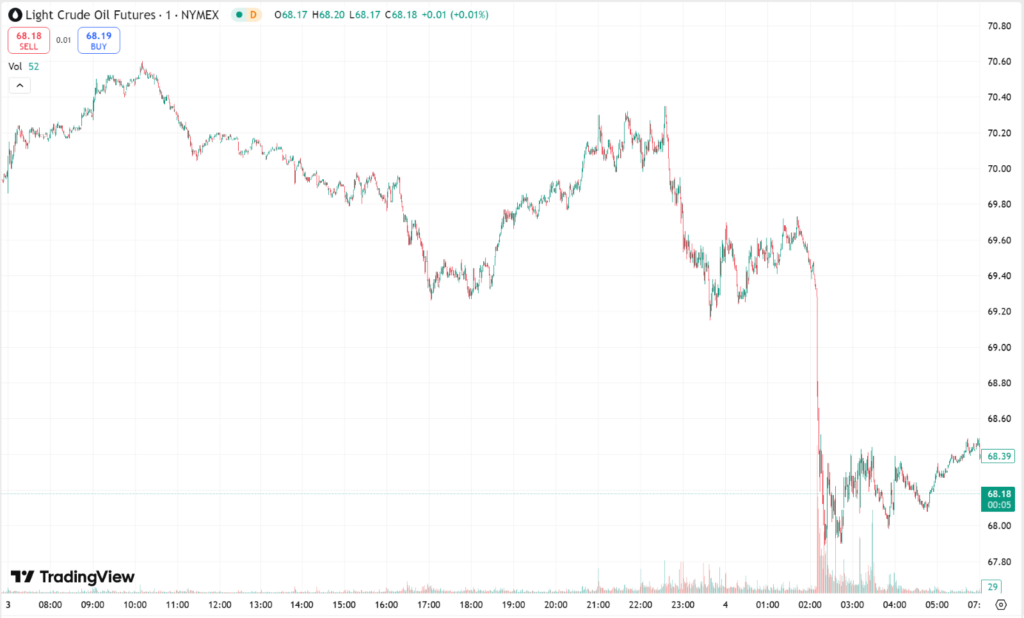
On Monday, gold prices surged over $30, closing at $2,893.67 per ounce, supported by safe-haven buying and a weaker US dollar after former President Donald Trump announced a 25% tariff on Mexico and Canada, set to take effect on April 4. Meanwhile, following pressure from Trump, OPEC+ unexpectedly announced an oil production increase starting in April, causing crude oil prices to drop.
Gold
According to reports, on Monday, March 3, Donald Trump confirmed that the 25% tariffs on Mexico and Canada would officially take effect on Tuesday, with additional retaliatory tariffs scheduled for April 2. This move heightened market uncertainty, boosting gold as a safe-haven asset.
Additionally, weak US economic data reinforced expectations of a Federal Reserve rate cut, pushing the dollar down nearly 1% to 106.55, further supporting gold prices.
- February US Manufacturing PMI fell to 50.3, signaling stagflation concerns.
- Raw material costs surged to their highest level in over two years.
- The Atlanta Fed’s GDPNow model projects Q1 GDP contraction at -2.8%, worsening from the previous forecast of -1.5%.
Daniel Pavilonis, Senior Market Strategist at RJO Futures, stated:
“We are in a very bullish gold market, and prices may break above $3,000… Tariffs and their retaliatory effects could prompt central banks to increase gold purchases.”
Technical Analysis & Trading Strategy
On Monday, gold faced resistance at the $2,876 level in the Asian-European session before pulling back. However, a strong rebound followed, with US trading hours driving prices above $2,890, indicating a return to broad-range price fluctuations.

Today’s Key Levels to Watch:
- Resistance: $2,905 – $2,910
- Support: $2,878 – $2,873
Trading Strategy: In today’s operation, it is recommended to consider going long on pullbacks and short on rebounds.
Crude Oil
On Monday, following Trump’s renewed pressure on OPEC, OPEC+ unexpectedly announced it would resume oil production increases in April, leading to a sharp decline in crude oil prices.
WTI crude oil futures (April contract) fell $1.39 (-1.99%) to $68.37 per barrel.
Brent crude oil futures (May contract) dropped $1.19 (-1.63%) to $71.62 per barrel.
OPEC+ Announces First Production Increase Since 2022
According to reports, OPEC+ confirmed on Monday that it would proceed with its planned April production increase. Previously, traders had widely expected OPEC+ to delay the decision due to persistently low oil prices, which have strained Saudi Arabia’s and other OPEC members’ government budgets.
- OPEC+ held an online meeting with eight member states and agreed to increase oil production from April.
- The group plans to increase production by 138,000 barrels per day (bpd) monthly, gradually phasing out the 2.2 million bpd production cuts.
- OPEC emphasized flexibility, stating that the production plan could be paused or reversed if necessary to maintain market stability.
Technical Analysis & Trading Strategy
On Monday, crude oil saw a brief rally to $70.6 before facing strong resistance and reversing downward, closing lower for the session.

Today’s Key Levels to Watch:
- Resistance: $2,905 – $2,910
- Support: $2,878 – $2,873
Trading Strategy: In today’s operation, it is recommended to consider rebounding from high altitudes as the main method, and secondary by retreating from lows and longs.
Forward Looking Statement Disclaimer
This document contains forward-looking statements, which can generally be identified by the words “expects,” “believes,” “continues,” “may,” “estimates,” “anticipates,” “hopes,” “intends,” “plans,” “potential,” “predicts,” “should,” “will,” or similar expressions. Such statements are based on CG FinTech’s current expectations and assumptions, but actual results could differ materially from those anticipated due to a number of risks and uncertainties. CG FinTech does not guarantee the accuracy or completeness of these statements and undertakes no obligation to update or revise any forward-looking statements.
Disclaimer
The information provided herein is for informational purposes only and does not constitute an offer or solicitation to buy or sell any financial instruments. Trading Contracts for Difference (CFDs) and foreign exchange (forex) carries a high level of risk and may not be suitable for all investors. It is important to fully understand the risks involved and seek independent financial advice if necessary.
